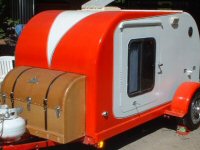Most marine wiring is made using tinned wire and most crimp connectors are tinned as well48Rob wrote:I can see your point about dissimilar metal contact from the metal inside a wire nut (only some wire nuts), but if that is the argument against, then what makes a crimp on connector different, as it also places "metal against wire?
If the tinning of the wire prevents it, that is good, but the act of crimping could easily remove some of the tinning.
If you crimp on a connector, and then tin, how can it get under the connector to provide complete coverage?
I've been wiring and redoing the factory wiring on sailboats for a number of years and I solder every connection I crimp just to ensure a good connection - Don't think it's 'required' . . . . it's just something I do so I don'tget any callbacks. It's a REALLY good idea to solder them if you're notusing tinned marine wire. I began many years ago soldering every connection in the bilge, as there are more wiring failures for bilge pumps than any other single thing and it worked out so well I just started soldering everything
Wire nuts have a sharp coil of metal in them that's not usually copper and it's purpopse is to gouge a groove in the conductors to ensure a good mechanical connection . . . . I think the electrical connection comes from compressing the twisted bundles of wire - But I'm no expert on wire nuts, so take that with a grain of salt - Not too much salt or you'll ruin your wire nut connection

If I had to use a wire nut, I would finish it off by forcing a dab of silicone sealant in the end to seal the wires and nut into an airtight 'bubble' . . . . something you could never accomplish even with a mile of electrical tape
Don
